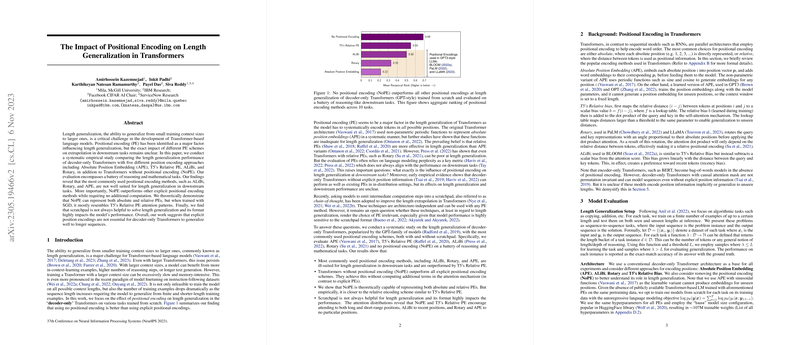Positional Encoding and Length Generalization in Transformers: An Analysis
The paper "The Impact of Positional Encoding on Length Generalization in Transformers" provides a detailed paper of positional encoding (PE) methods and their effects on the length generalization capabilities of decoder-only Transformers. This work systematically evaluates different PE strategies, including Absolute Position Embedding (APE), T5's Relative PE, ALiBi, and Rotary, against models without explicit positional encodings (NoPE) using a suite of synthetic tasks.
Methodology
The researchers explore the length generalization problem by focusing on algorithmic tasks such as addition, polynomial evaluation, sorting, and more. These tasks require models to extrapolate from trained context sizes to unseen longer ones, providing a robust framework for testing PE efficacy. Notably, this setup eschews pre-trained LLMs and instead trains Transformers from scratch using a consistent architecture but varying PE methods.
Positional Encoding Schemes
- Absolute Position Embedding (APE): This method associates a unique vector to each absolute position but struggles with generalization beyond trained lengths.
- T5's Relative PE: Maps the relative distance between tokens to biases in the attention mechanism, demonstrating superior performance in length generalization tasks.
- ALiBi: Similar to T5's scheme but with a linearly growing bias, which performs moderately.
- Rotary: Applies rotations to encode relative positions; however, it showed suboptimal performance akin to APE in extrapolation tests.
- NoPE: Despite having no explicit positional encoding, models with NoPE surprisingly matched or outperformed T5's Relative PE, challenging the necessity of explicit PE.
Key Findings
- Empirical Insights: NoPE achieved impressive generalization results without additional computational overhead, suggesting that explicit positional encoding might be unnecessary for decoder-only Transformers.
- Theoretical Validation: The paper provides a theoretical basis for NoPE's ability to implicitly embody both absolute and relative position encodings. It demonstrates that the model, guided by gradient descent, tends toward a representation akin to T5's Relative PE.
- Scratchpad Influence: While scratchpad or chain-of-thought (CoT) methods can aid in length generalization, their impact is task-dependent and heavily influenced by the scratchpad format. Notably, scratchpad techniques do not inherently overcome weaknesses in positional encoding during extrapolation scenarios.
Implications
The findings suggest re-evaluating the need for explicit positional encodings within decoder-only Transformers. NoPE's performance, combined with T5's Relative PE emerging as the top explicit method, indicates a potential shift in how PEs might be designed and employed in future architectures. The paper's demonstration that NoPE can match, if not exceed, explicit methods earmarks it as a promising area for further exploration.
Future Directions
Given the results, future research might focus on:
- Scaling Evaluations: Extending these tests to larger models with varied pre-trained datasets.
- Further Theoretical Exploration: Expanding the theoretical understanding of how Transformers without explicit PE adapt and learn to recognize token positions.
- Broader Task Evaluation: Applying these insights to a wider range of downstream tasks, including natural language processing applications, to assess the broader applicability of NoPE models.
This paper provides valuable insights into positional encoding strategies with strong empirical and theoretical backing, suggesting significant possibilities for refining Transformer models in both research and applied contexts.
